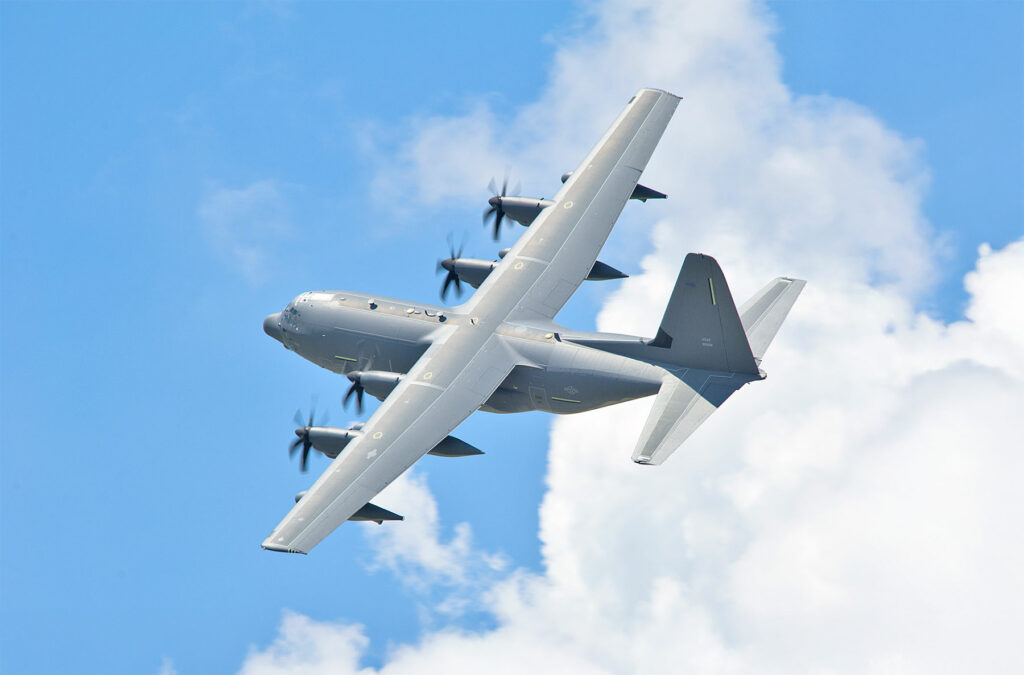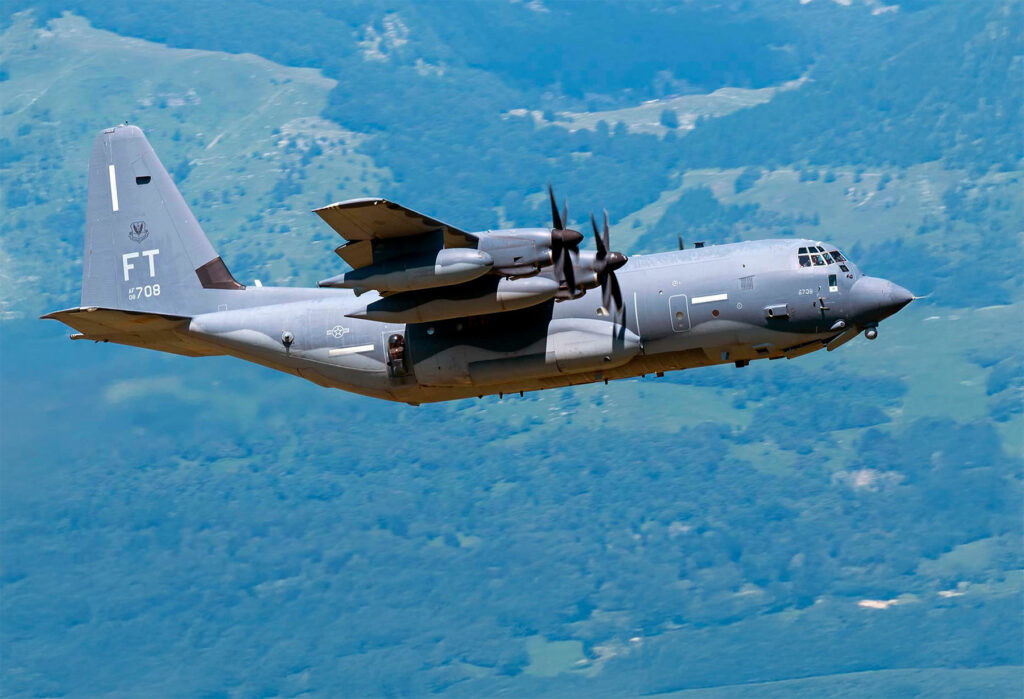Lockheed HC-130J Combat King II: a multi-role search and rescue aircraft optimized for personnel recovery, with advanced avionics and refueling capabilities.
In brief
The Lockheed HC-130J Combat King II is a long-range, multi-mission search and rescue aircraft, primarily used by the U.S. Air Force. Derived from the C-130J Hercules, the HC-130J is designed for personnel recovery in hostile environments, with capabilities for aerial refueling, medical evacuation, and cargo transport. Powered by four Rolls-Royce AE 2100D3 turboprop engines, it achieves a maximum speed of 362 knots (670 km/h) and an extended range with fuel tanks. The HC-130J includes advanced sensors, radar, and secure communication systems for accurate tracking and mission support. Additionally, the aircraft can refuel both helicopters and tiltrotor aircraft mid-mission, extending the operational range of search and rescue teams. Equipped with robust defensive systems, it operates effectively in contested areas, making it an essential component in combat search and rescue (CSAR) and personnel recovery missions.
The Lockheed HC-130J Combat King II
The Lockheed HC-130J Combat King II is the U.S. Air Force’s premier combat rescue and personnel recovery aircraft, built on the proven C-130J Super Hercules platform. Known for its versatility and durability, the HC-130J is tailored for combat search and rescue (CSAR) missions, particularly in hostile or remote environments. It combines the reliable airframe of the C-130 with advanced mission-specific equipment, allowing it to support operations such as aerial refueling, medical evacuation, and cargo transport. The HC-130J is designed to deliver aid and evacuate personnel from austere locations, serving as a critical asset in modern military operations. Its unique refueling capability enables helicopters and other aircraft to extend their range, making the HC-130J indispensable in situations where time and access are crucial.

History of the Development of the Lockheed HC-130J Combat King II
The HC-130J Combat King II originated from a need within the U.S. Air Force for a reliable, long-range search and rescue aircraft capable of operating in hostile environments. By the 1990s, the existing HC-130P/N models, based on earlier Hercules variants, were aging and lacked the advanced avionics, power, and range needed for modern combat search and rescue missions. These older models had limitations in operational efficiency, fuel capacity, and mission adaptability, prompting the Air Force to seek a replacement with enhanced capabilities for personnel recovery, particularly in contested areas.
The U.S. Air Force launched the development of a next-generation combat rescue aircraft in the late 1990s as part of a broader modernization program. The objective was to create an aircraft that could conduct personnel recovery, medical evacuation, and refueling missions efficiently across a wide range of environments. Lockheed Martin, already a trusted defense contractor with experience in developing the C-130 Hercules variants, proposed a new model based on the C-130J Super Hercules platform.
The HC-130J development officially began in the early 2000s, with the goal of integrating advanced technology into the C-130J’s robust airframe. The C-130J variant had already proven successful, known for its upgraded engines, digital avionics, and enhanced fuel efficiency. Lockheed’s plan for the HC-130J involved equipping it with specialized equipment for search and rescue missions, including enhanced radar, infrared sensors, and secure communication systems essential for personnel recovery operations.
On July 29, 2010, the HC-130J Combat King II took its first flight, marking a significant milestone in U.S. Air Force aviation. The aircraft was equipped with mission-specific modifications that enabled it to conduct operations in low-visibility and high-risk areas. With the introduction of a NATO designation, the HC-130J quickly became a strategic asset within U.S. military operations, specifically for Air Force Special Operations and Air Combat Command.
The Combat King II was developed with advanced mission flexibility in mind, allowing it to perform roles beyond traditional search and rescue. Its refueling capability extended the range of helicopters and tiltrotor aircraft, such as the HH-60G Pave Hawk, which are often deployed for personnel recovery. Additionally, the HC-130J’s defensive countermeasures allow it to evade enemy radar and missile threats, making it suitable for operations in hostile regions.
Since its initial deployment, the HC-130J has become central to U.S. Air Force CSAR missions and has been a key element in multiple combat zones. Its ability to refuel in mid-air has enhanced operational reach, allowing the U.S. Air Force to conduct personnel recovery missions across vast distances. With ongoing upgrades to its avionics, communication systems, and radar, the HC-130J continues to evolve, maintaining its relevance in complex and dynamic operational environments.
Design of the Lockheed HC-130J Combat King II
The HC-130J Combat King II’s design is based on the C-130J Super Hercules, adapted specifically for CSAR and personnel recovery missions. This configuration combines a robust airframe with mission-critical equipment, allowing it to operate effectively in contested and austere environments.
Airframe and Structure: The HC-130J is designed with a 38.8-meter (127-foot) fuselage length and a wingspan of 40.4 meters (132.6 feet), providing stability and cargo capacity for mission-specific equipment and personnel. The airframe is reinforced to withstand the demands of rough terrain and unpaved runways, allowing for landings in remote locations.
Propulsion System: The HC-130J is powered by four Rolls-Royce AE 2100D3 turboprop engines, each producing 4,637 horsepower. These engines drive six-blade, composite propellers designed to increase thrust while reducing drag. This setup provides the HC-130J with excellent fuel efficiency and allows it to sustain long-endurance missions.
Radar and Sensor Systems: The HC-130J incorporates an advanced AN/APN-241 radar system, which is capable of low-altitude flight following, a critical feature for terrain navigation and evasion. Additionally, the HC-130J is equipped with electro-optical/infrared (EO/IR) systems for night and low-visibility operations, giving it robust search capabilities.
Aerial Refueling Capability: One of the HC-130J’s defining features is its ability to perform aerial refueling. Equipped with external fuel tanks and a refueling system, the HC-130J can extend the operational range of rotary-wing and tiltrotor aircraft, allowing for prolonged mission durations in remote areas.
Defensive Systems: The aircraft includes electronic countermeasures and flare and chaff dispensers to evade radar-guided and heat-seeking missiles, enhancing survivability in contested airspace.
Interior Layout and Cargo Capacity: Inside, the HC-130J is equipped with seating arrangements and storage configurations to accommodate search and rescue teams, medical personnel, and patients. The cargo hold can support stretchers for medical evacuation and has a payload capacity exceeding 35,000 pounds (15,876 kg), allowing it to transport essential equipment and supplies for mission success.
Advantages and Drawbacks: While the HC-130J’s multi-role design provides significant versatility, its large size and slow speed make it less agile than smaller aircraft. However, its enhanced fuel efficiency, refueling capability, and extensive range compensate for these limitations, making it a reliable platform in rescue missions over challenging terrain.
Performance of the Lockheed HC-130J Combat King II
The HC-130J Combat King II’s performance is optimized for long-range, high-endurance operations in support of CSAR missions. Powered by four Rolls-Royce AE 2100D3 turboprops, the HC-130J delivers reliable power and efficiency, essential for extended missions in remote regions.
Engine Power and Speed: Each of the Rolls-Royce engines produces 4,637 horsepower, allowing the aircraft to reach a maximum speed of 362 knots (670 km/h). This speed is crucial for rapid response, ensuring the HC-130J can deploy quickly to provide support for personnel recovery operations.
Range and Endurance: The HC-130J has an operational range of 4,000 nautical miles (7,408 kilometers) when carrying additional fuel tanks. This extended range is vital for CSAR missions that require continuous presence or operations in remote, high-risk zones. Its endurance enables the HC-130J to perform prolonged missions without requiring refueling, allowing for extensive coverage during search and rescue.
Altitude Capability: With a maximum altitude of 28,000 feet (8,534 meters), the HC-130J can operate above weather systems or enemy fire, increasing its survivability and effectiveness in both rescue and refueling roles.
Payload Capacity: The HC-130J’s cargo hold can support up to 35,000 pounds (15,876 kg), allowing it to transport necessary supplies, personnel, or equipment required for recovery missions. This payload flexibility is essential for providing comprehensive support to ground forces or for transporting medical patients and rescue teams.
Comparison with Other Aircraft: The HC-130J’s capabilities place it in a distinct category compared to other CSAR and tactical airlift aircraft. The MC-130J Commando II, another variant of the C-130J, shares similar features but is geared toward special operations rather than dedicated search and rescue. The HC-130J’s refueling capability and endurance also give it a broader operational range compared to rotary-wing CSAR aircraft like the HH-60G Pave Hawk, which depends on aerial refueling for extended missions.
Variants of the Lockheed HC-130J Combat King II
The HC-130J Combat King II has several variants, each tailored for specific mission roles within the U.S. Air Force.
- HC-130J Combat King II (Standard): The primary CSAR and personnel recovery variant, equipped with advanced radar, EO/IR sensors, aerial refueling systems, and defensive countermeasures for operations in contested areas.
- MC-130J Commando II: While not a direct variant of the HC-130J, the MC-130J shares the C-130J platform. The MC-130J is focused on special operations, including infiltration, exfiltration, and resupply missions for special forces. It has unique systems for low-level, clandestine operations.

Military Use and Combat of the Lockheed HC-130J Combat King II
The Lockheed HC-130J Combat King II plays a critical role in combat search and rescue (CSAR) missions, providing aerial refueling and personnel recovery capabilities. Its primary role within the U.S. Air Force’s Air Combat Command (ACC) and Air Force Special Operations Command (AFSOC) is to retrieve personnel from hostile or remote areas, often in complex and dangerous conditions.
Armament and Defense Systems: Although not primarily an armed aircraft, the HC-130J is equipped with defensive countermeasures to protect against enemy threats. It carries chaff and flares for evading radar-guided and heat-seeking missiles, as well as electronic warfare systems that disrupt enemy targeting systems. These defensive capabilities enable the HC-130J to operate in contested environments where enemy forces may be present.
Refueling Operations: The HC-130J is unique in its ability to refuel both fixed-wing and rotary-wing aircraft mid-mission, making it indispensable for supporting rescue helicopters and other CSAR assets. Its refueling capability extends the operational range of aircraft like the HH-60G Pave Hawk and the CV-22 Osprey, allowing these aircraft to reach remote areas or sustain operations for prolonged periods. This capability is particularly valuable in large-scale operations or prolonged conflicts where continuous aerial support is necessary.
Medical Evacuation and Personnel Recovery: The HC-130J’s interior can be configured for medical evacuation, with space for stretchers and life-support equipment. This capability enables the aircraft to retrieve and provide medical care to injured personnel in the field. Additionally, the HC-130J is equipped to deploy search and rescue teams, providing them with essential equipment and logistical support during recovery operations.
Operational Deployments: The HC-130J has been actively deployed in various combat zones, including the Middle East and Africa, where it has supported U.S. and allied operations. In Afghanistan, the HC-130J provided crucial refueling and support capabilities, allowing U.S. forces to conduct extensive search and rescue missions across challenging terrain. The aircraft’s endurance and versatility made it a key asset in ensuring personnel recovery and extending the operational reach of rotary-wing assets.
Allied Operations and Support: While the HC-130J has primarily served U.S. forces, it has also supported allied operations through interoperability programs and joint training exercises. The HC-130J’s refueling capability has been particularly valuable in joint operations where rotary-wing assets from allied nations require extended range. Its contribution to personnel recovery and refueling has strengthened the capabilities of joint rescue forces in complex combat scenarios.
The HC-130J remains in active service, with ongoing upgrades and modernization programs to enhance its communication systems, radar capabilities, and survivability in high-threat environments. This ensures that the HC-130J continues to meet the evolving demands of CSAR missions and personnel recovery, solidifying its role as an essential component in U.S. Air Force operations.
Back to the Special Aircraft section